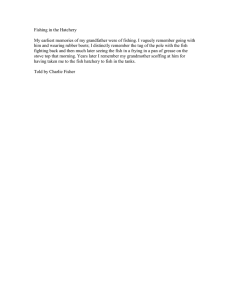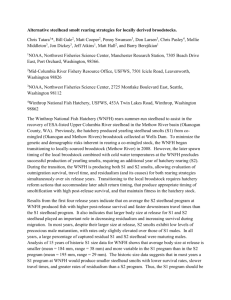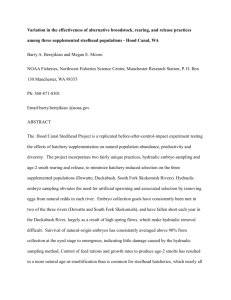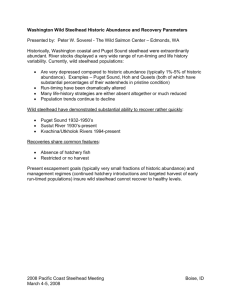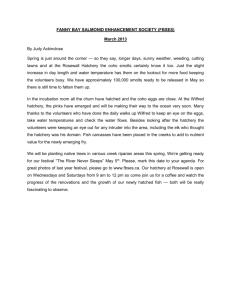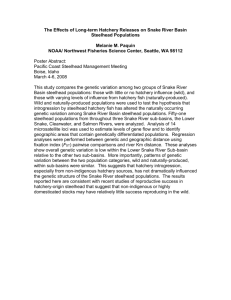Lolo - Hatchery Reform
advertisement
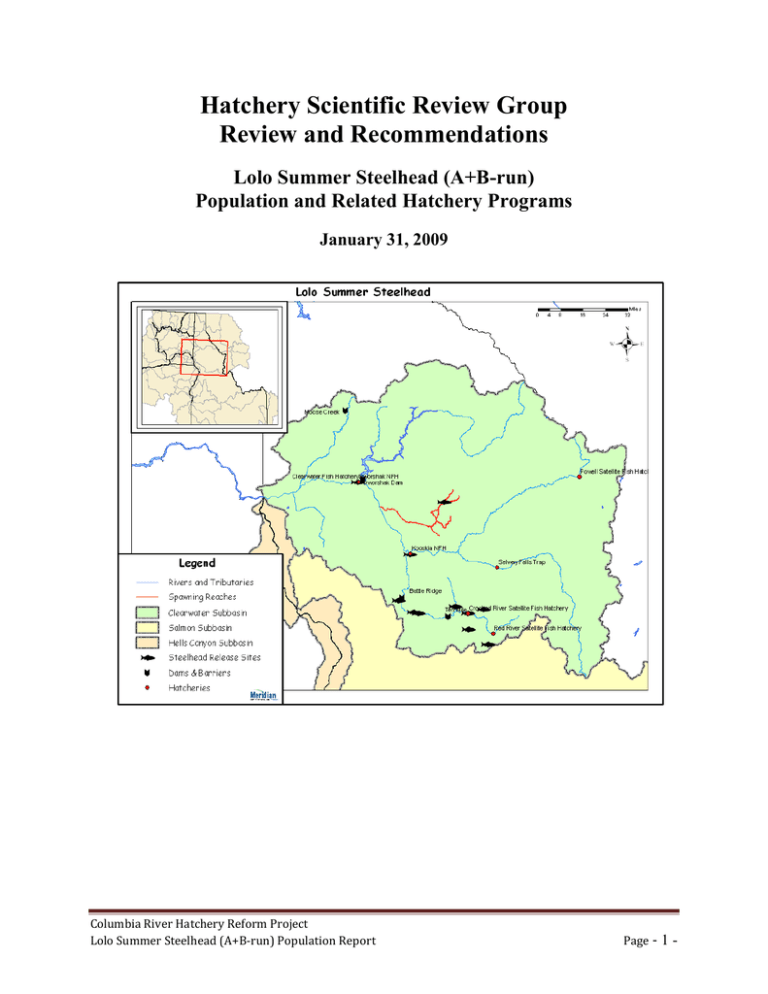
Hatchery Scientific Review Group Review and Recommendations Lolo Summer Steelhead (A+B-run) Population and Related Hatchery Programs January 31, 2009 Columbia River Hatchery Reform Project Lolo Summer Steelhead (A+B-run) Population Report Page - 1 - 1 Lolo Summer Steelhead (A+B-run) The Lolo Creek steelhead population is part of the Snake River Basin Steelhead Distinct Population Segment (DPS) that includes all naturally-spawned populations of steelhead in the Snake River Basin of southeast Washington, northeast Oregon, and Idaho (62 FR 43937; August 18, 1997). Several artificial propagation programs are considered part of the DPS: the Tucannon River natural stock, the North Fork Clearwater River stock reared at Dworshak National Fish Hatchery and Clearwater Fish Hatchery and released in the Clearwater and Salmon rivers 1, East Fork Salmon River local stock, and the Little Sheep Creek/Imnaha River Hatchery steelhead programs. The DPS was listed as a threatened under the ESA on August 18, 1997; this status was reaffirmed on January 5, 2006. The DPS has six major population groupings (MPGs): Lower Snake River, Clearwater River, Grande Ronde River, Salmon River, Hells Canyon, and the Imnaha River (ICTRT 2006), and contains both A and B-run steelhead (based on migration timing, ocean-age and adult size). The Lolo Creek population contains both A-run and B-run adult life history types and is included in the Clearwater River MPG. Like all populations in the MPG, the Lolo Creek population occupies areas upstream from the historical Lewiston Dam, which was in place from 1927 to 1973. Although the dam was fitted with a fish ladder, it provided only marginal passage for migrating steelhead adults and smolts (Cramer et al. 1998). Unlike Chinook salmon, steelhead were able to maintain access to the Clearwater River subbasin during the dam’s existence; therefore they are included in the DPS. A steep-gradient narrow canyon approximately 15 miles upstream of the mouth of Lolo Creek separates the upper and lower production areas. The lower production area is thought to be used by A-run fish and the upper area by B-run fish. The Interior Columbia Technical Recovery Team (ICTRT) classified the Lolo Creek population as a “Basic” population based on historical habitat potential (ICTRT 2005). A “Basic” population is one that requires a minimum abundance of 500 natural spawners and an intrinsic productivity greater than 1.15 recruits per spawner (R/S) to meet the 5% extinction risk criteria established by the ICTRT. According the Draft Snake River Steelhead Recovery Plan, Snake River Basin steelhead trout enter fresh water from June to October and spawn during the following spring from March to May. Emergence occurs by early June in low elevation streams and as late as mid-July at higher elevations. Snake River steelhead usually smolt at age-2 or age-3 years and reside in marine waters for 1 to 3 years prior to returning to their natal stream to spawn at 4 or 5 years of age. There are no estimates of historical steelhead abundance in Lolo Creek. 2 Current Conditions Steelhead spawn in the mainstem of Lolo Creek (from Musselshell Creek to Yoosa Creek) and in any accessible tributaries in upper Lolo Creek drainage, and Yoosa Creek drainage. Some limited spawning may also occur in the Musselshell Creek and Eldorado Creek drainages (USFS 2006). Although current natural abundance (number of adults 1 Artificial propagation programs for steelhead in the Clearwater River subbasin are based on the North Fork Clearwater stock trapped at the base of Dworshak Dam when its construction blocked access to the North Fork in 1969. Columbia River Hatchery Reform Project Lolo Summer Steelhead (A+B-run) Population Report Page - 2 - spawning in natural production areas) is unknown for this population, the number of natural-origin steelhead adults migrating and spawning within the Lolo Creek drainage is considered very low (USFS 2006). In response to this lack of abundance data, the ICTRT developed a generic dataset for Brun steelhead populations to be used for a preliminary assessment of abundance productivity risk (ICTRT 2005). The dataset was derived by distributing the naturalorigin steelhead counted annually at Lower Granite Dam equally across the nine extant B-run populations found above the dam. Abundance for the generic B-run steelhead in recent years has been moderately variable; the most recent 10-year geometric mean number of natural spawners was 272 fish. From 1986-1998, returns per spawner for the generic “B” run steelhead dataset ranged from 0.24 (1990) to 6.63 (1998). The most recent 13-year SAR adjusted and delimited geometric mean of returns per spawner was 0.85. The A-run component of this population was not included in the generic abundance/productivity risk assessment. The population is predominantly sustained by B-run production; A-run fish are believed to occupy only the lower 10 to 15 miles of Lolo Creek. For AHA modeling, IDFG estimated natural-origin fish escapement and adjusted productivity for this population to be 92 and 0.89, respectively. 2.1 Current Population Status and Goals This section describes the current population, status, and goals for the Lolo Creek steelhead population. 2.2 ESA Status: The Snake River Basin steelhead DPS was listed as threatened on August 18, 1997; the threatened status was reaffirmed on January 5, 2006. Population Description: For the purpose of this review, the HSRG assigned this population as Contributing. The population currently meets the broodstock criteria for a Stabilizing population designation. Recovery Goal for Abundance: The ICTRT defined the Lolo Creek A/B-run steelhead population as “Basic” and identified a minimum abundance threshold of 500 natural-origin adults. Productivity Improvement Expectation: The ICTRT productivity standard associated with a population defined as “Basic” is 1.30. Habitat Productivity and Capacity: Productivity: 2.0; Capacity: 200. Current Hatchery Programs Affecting this Population Artificial propagation programs for steelhead in the Clearwater River subbasin are based on the North Fork Clearwater B-run stock that was trapped at the base of Dworshak Dam when the dam was constructed on the North Fork in 1969. This stock has been outplanted into the Lolo Creek population intermittently since 1977. Fry were released for six years (1977-1983), fingerlings for five years (1985-1991), smolts for six years (1989-2005) and adults for six years (1978-2002). Annual releases have ranged from 40,000 to 625,000 fry, 11,000 to 202,000 fingerlings, 18,000 to 53,000 smolts and 150 to 1,150 adults (ICTRT 2005). Currently, a Lolo Creek supplementation program operates out of the Clearwater Hatchery using Dworshak NFH B-run steelhead stock. The release goal for this program is 50,000 smolts. Fish are released at approximately 4.5 fish per pound and all smolts are Columbia River Hatchery Reform Project Lolo Summer Steelhead (A+B-run) Population Report Page - 3 - unmarked with the exception of a PIT-tag group of 1,000 fish. Broodstock is collected at the Dworshak NFH and all juveniles are reared at the Clearwater Hatchery. No naturalorigin adults are spawned. The program has an R/S for of 35.0. Estimated number of hatchery strays affecting this population: Hatchery strays from integrated in-basin programs: 628 Hatchery strays from in-basin segregated and out-of-basin hatchery programs: 141 3 HSRG Review The HSRG has developed guidelines for minimal conditions that must be met for each type of program as a function of the biological significance of the natural populations they affect. For populations of the highest biological significance, referred to as Primary, the proportion of effective hatchery-origin spawners (pHOS) should be less than 5% of the naturally spawning population, unless the hatchery population is integrated with the natural population. For integrated populations, the proportion of natural-origin adults in the broodstock should exceed pHOS by at least a factor of two, corresponding to a proportionate natural influence (PNI) value of 0.67 or greater. For Contributing populations, the corresponding guidelines are: pHOS less than 10% or PNI greater than 0.5. It is important to note that these represent minimal conditions, not targets. For example, the potential for fitness loss when effective pHOS is 5% is significantly greater than it would be at 3%. For Stabilizing populations, we assume the current pHOS or PNI would be maintained. The HSRG analyzed the current condition and a range of hatchery management options for this population, including the effect of removing all hatchery influence, and arrived at one or more proposed solutions intended to address the manager’s goals consistent with the HSRG guidelines for Primary, Contributing, and Stabilizing populations. The solution included in the cumulative analysis is the last option described in the Observations and Recommendation box below. In order to highlight the importance of the environmental context, two habitat scenarios were considered: current conditions and a hypothetical 10% habitat quality improvement. See HSRG Observations and Recommendations in the box below for more information. 3.1 Effect on Population of Removing Hatchery The No Hatchery scenario is intended to look at the potential of the natural population absent all hatchery effects with projected improved fish passage survival in the Snake and Columbia mainstem (FCRPS Biological Opinion May 5, 2008). Our analysis estimated that Adjusted Productivity (with harvest and fitness factor effects from AHA) would increase from 0.9 to 1.8. Average abundance of natural-origin spawners (NOS) would increase from approximately 92 fish to approximately 85 fish. The harvest contribution of the natural and hatchery populations would go from approximately 115 fish to approximately 12 fish. 3.2 HSRG Observations/Recommendations In the Observation and Recommendation box below we describe elements of the current situation (Observations) that were important to evaluate the natural population and where applicable, the hatchery program(s) affecting that population. We also describe a Columbia River Hatchery Reform Project Lolo Summer Steelhead (A+B-run) Population Report Page - 4 - solution (Recommendations) that appeared to be consistent with manager’s goals; however, this is not the only solution. In some cases more than one solution is described. Summary results of this analysis are presented in Table 1. The adjusted productivity values reported for each alternative incorporates all factors affecting productivity (i.e., habitat quality, hatchery fitness effects, and harvest rates). Observations Managers have identified a strategy for Lolo Creek A/B-run steelhead that emphasizes maintaining existing natural spawning populations and using hatchery-origin steelhead in an attempt to augment natural production. Currently, this population is not consistent with the HSRG-defined standards for either a Primary or Contributing population designation (pHOS exceeds 0.10). As currently operated, approximately 50,000 Dworshak National Fish Hatchery smolts are outplanted in Lolo Creek annually. Of these, all are released with adipose fins intact. The HSRG observes that population capacity and productivity in this basin appears to be very limited. This makes achieving the manager’s conservation goals very difficult. The HSRG also notes that there is a general lack of information related to steelhead abundance, productivity, spatial structure and diversity as well as straying of hatchery fish into natural production areas. Recommendations Given the small capacity and low productivity of this population, the HSRG was unable to develop a solution that would achieve the HSRG-defined standards of a Primary population. The low capacity of the population used in our evaluation will allow only an integrated hatchery program up to the current size of 50,000 smolts. At this size, the program would be consistent with HSRG-defined standards for a Contributing population. It also appears that achieving the basic population level defined by the TRT will not be possible without significant improvements in habitat and passage. The HSRG recommends terminating the use of Dworshak B-run steelhead for the Lolo Creek program. The HSRG recommends developing an integrated conservation program with naturalorigin returns to Lolo Creek. The managers should coordinate the programming of all salmon populations reared in the Clearwater Fish Hatchery, Dworshak National Fish Hatchery, Kooskia National Fish Hatchery and Nez Perce Tribal Hatchery to maximize the benefits of available water supply, appropriate water temperature, and rearing containers. Operating these four major hatcheries as a coordinated system would facilitate the movement of programs/populations between and among the different hatcheries. This would maximize survival by producing fish in good condition for release at the appropriate life stage. An effort should be made to improve the information base about this population and a more refined analysis of habitat capacity and productivity needs to be done. This improved information base will be important to determining what combination of habitat and hatchery programs will be the most effective in this basin. Columbia River Hatchery Reform Project Lolo Summer Steelhead (A+B-run) Population Report Page - 5 - Table 1. Results of HSRG analysis of current condition and HSRG Solution for Lolo Creek Summer Steelhead (Aand B-run). The light green row indicates the natural population and yellow indicates the segregated hatchery population, if applicable. A 10% habitat improvement is applied to the HSRG Solution to evaluate the additional effect of improved habitat towards conservation objectives. Alternative Type and Purpose Current Int Cons No Hatchery Int Cons HSRG Solution HSRG Solution w/ Improved Habitat Prog Size (/1000) HOR Recapture Additional Weir Efficiency Effective pHOS PNI 49.7 10% 0% 68% 0.00 0% NOS Esc Adj Prod Harvest Hatchery Surplus 92 0.9 115 70 1.00 85 1.8 12 - Int Cons 49.4 0% 0% 83% 0.55 124 1.3 122 0 Int Cons 49.4 0% 0% 81% 0.55 140 1.4 124 0 Columbia River Hatchery Reform Project Lolo Summer Steelhead (A+B-run) Population Report Page - 6 -
